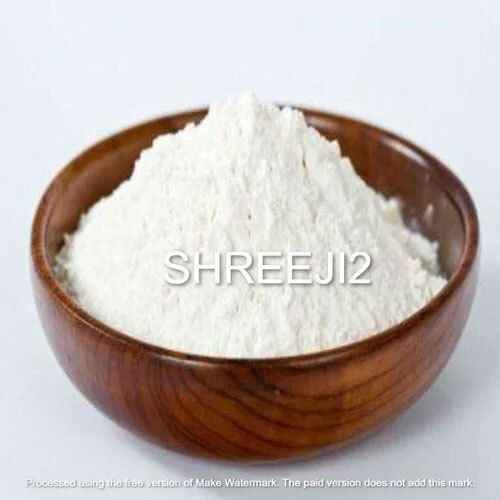Magnesium Hydroxide
100 INR/Kilograms
Product Details:
- Smell No Smell
- Heavy Metal (%) NMT 30 PPM
- Loss on Drying NMT 2.0 %
- Particle Size 90% passing through 325 mesh
- Molecular Formula H2MgO2
- Structural Formula H2MgO2
- Melting Point 350
- Click to View more
X
Magnesium Hydroxide Price And Quantity
- 100.00 - 120.00 INR/Kilograms
- 25 Kilograms
- 100 INR/Kilograms
Magnesium Hydroxide Product Specifications
- Magnesium hydroxide
- 1-5 Years
- 350
- 90% passing through 325 mesh
- H2MgO2
- H2MgO2
- Medicine Grade
- NMT 30 PPM
- NMT 2.0 %
- 1309-42-8
- No Smell
- Magnesium hydroxide is used as a laxative to relieve occasional constipation. Magnesium hydroxide is also used as an antacid to relieve indigestion, sour stomach, and heartburn.
- 8.7 to 12.5
- 99.2
- decomposes
- Pharmaceutical Intermediates
- Room Temperature
- Odorless
- Powder
- 215-170-3
- 58.33 Grams (g)
- 28161010
- Magnesia 50H
- soluble in water
- White to Almost White powder
Magnesium Hydroxide Trade Information
- any indian port
- Cash Advance (CA) Cash Against Delivery (CAD) Letter of Credit (L/C) Letter of Credit at Sight (Sight L/C) Cash in Advance (CID)
- 100 Kilograms Per Day
- 7 Days
- Free samples are available
- DRUM PACK
- Western Europe Australia South America Eastern Europe Middle East Central America Asia North America Africa
- All India
- GMP/ISO
Product Description
Magnesium hydroxide is a chemical compound with the formula Mg(OH)2. It is an inorganic compound that occurs naturally as the mineral brucite. It is also commonly known as milk of magnesia, which is a suspension of the compound in water.
Magnesium hydroxide is a white solid that is insoluble in water, but it can react with acids to form salts. It is commonly used as an antacid to neutralize stomach acid and relieve indigestion and heartburn. It is also used as a laxative to treat constipation, as well as in various industrial applications, such as as a flame retardant in plastics and as a stabilizer in PVC.
Magnesium hydroxide is generally considered safe for human consumption and is listed as an approved food additive by the US Food and Drug Administration (FDA). However, excessive intake of this chemical compound can lead to diarrhea and other digestive problems.
Magnesium Hydroxide Properties:
- CAS No.: 1309-42-8
- Formula: H2MgO2
- Molecular Weight: 58.33
- Synonyms: Magnesia 50H;Magnesium dihydroxide;Magnesium(II) hydroxide
- EINECS: 215-170-3
- Density: 2.36 g/cm3
- Melting Point: 350 degree centigrade (lit.)
- Solubility: 0.9 mg/100 mL (18 degree centigrade) in water
- Appearance: odorless white powder
- Risk Codes: 36/37/38
How Does It Work:
Magnesium hydroxide belongs to a class of medications called saline laxatives. Water is retained with the stool as a result of its action. Additionally, it softens the stool, allowing it to pass more easily.
Applications. Or Where It Is Used:
Laxatives, such as magnesium hydroxide, are used to relieve constipation. It can also be used to relieve indigestion, stomach aches, and heartburn.
Manufacturing Process:
- Magnesium hydroxide can now be prepared using the following methods:
- Salts are decomposed thermally into oxides and their subsequent hydration.
- It is precipitated with alkali directly from magnesium salt solutions.
How To Use:
To swallow a chewable tablet, you must chew it first. This medicine should be taken with a full glass of water (8 ounces). The laxative properties of magnesium hydroxide should lead to bowel movements within 30 to 6 hours after taking it.
Side Effects:
Side effects of magnesium hydroxide are:
- Abdominal cramping
- Low blood pressure (Hypotension)
- Muscle weakness
- Diarrhea
- Electrolyte imbalance
- Respiratory depression
Frequently Asked Questions:
1. What is magnesium hydroxide used for?
Ans: It is commonly used as an antacid to treat indigestion and heartburn, as well as a laxative to relieve constipation. It is also used in various industrial applications.
2. Is magnesium hydroxide safe?
Ans: It is generally considered safe for human consumption and is listed as an approved food additive by the US FDA. However, excessive intake of magnesium hydroxide can lead to diarrhea and other digestive problems.
3. How does magnesium hydroxide work?
Ans: It works by neutralizing stomach acid, which can help alleviate symptoms of indigestion and heartburn. It also helps to increase the water content of the stool, making it easier to pass.
4. Can magnesium hydroxide be taken with other medications?
Ans: It can interact with certain medications, so it is important to talk to a doctor or pharmacist before taking it with other medications.
5. How should magnesium hydroxide be taken?
Ans: It is typically taken orally as a liquid or tablet. It is important to follow the dosage instructions provided by a doctor or pharmacist.
6. What are the side effects of magnesium hydroxide?
Ans: The most common side effect is diarrhea. Other possible side effects include nausea, vomiting, and stomach cramps.
Tell us about your requirement

Price:
Quantity
Select Unit
- 50
- 100
- 200
- 250
- 500
- 1000+
Additional detail
+91
Email










 : nilesh.sheth70
: nilesh.sheth70
